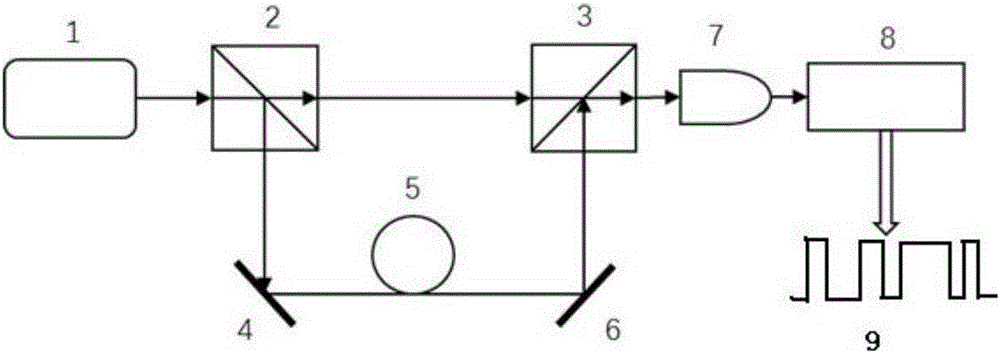Generating device for true random number based on phase noise
A phase noise and true random number technology, applied in the field of quantum random numbers, can solve problems such as fiber jitter noise, quantum random number bias, etc., and achieve the effect of improving quality, eliminating classical noise, and avoiding delay operations
- Summary
- Abstract
- Description
- Claims
- Application Information
AI Technical Summary
Problems solved by technology
Method used
Image
Examples
Embodiment 1
[0054] The present invention can only use one laser, and its structural schematic diagram is as follows figure 2 As shown, along the signal flow direction, it includes a laser, an attenuator, a beam splitter, an acoustic light modulator, a 2*2 polarization beam splitter, two photodetectors, a multiplier, and a low-pass filter 1. An analog-to-digital converter. Among them, the laser is used to emit a beam of laser light. Since the laser generates laser light (mainly stimulated radiation), it will inevitably generate spontaneous radiation at the same time. The combined effect of a large number of spontaneous radiation will cause phase fluctuations in the laser, that is, What we call phase noise comes from spontaneous radiation with quantum effects, so it has true randomness.
[0055] One end of the attenuator is connected to the laser, and the other end is connected to one end of the beam splitter. The attenuator is used to control the light intensity to prevent the laser gene...
Embodiment 2
[0084] The present invention can also adopt two lasers, and its structural diagram is as follows image 3 As shown, two lasers, two attenuators, a 2*2 polarization beam splitter, two photodetectors, a multiplier, a low-pass filter, and an analog-to-digital converter are sequentially included along the signal flow direction. Two of the lasers are used to emit two laser beams respectively. Since the laser generates laser light (mainly stimulated radiation), it will inevitably generate spontaneous radiation at the same time, and the combined effect of a large number of spontaneous radiation will cause phase fluctuations in the laser. , which is what we call phase noise, it comes from spontaneous radiation with quantum effects, so it has true randomness.
[0085] One end of the two attenuators is respectively connected to two lasers, and the other end is connected to two ports on the same end of a 2*2 polarizing beam splitter. The attenuators are used to control the light intensit...
PUM
 Login to View More
Login to View More Abstract
Description
Claims
Application Information
 Login to View More
Login to View More - R&D
- Intellectual Property
- Life Sciences
- Materials
- Tech Scout
- Unparalleled Data Quality
- Higher Quality Content
- 60% Fewer Hallucinations
Browse by: Latest US Patents, China's latest patents, Technical Efficacy Thesaurus, Application Domain, Technology Topic, Popular Technical Reports.
© 2025 PatSnap. All rights reserved.Legal|Privacy policy|Modern Slavery Act Transparency Statement|Sitemap|About US| Contact US: help@patsnap.com



